



Next: The Old Stellar Population
Up: NICMOS Science
Previous: The Formation and Evolution
Subsections
Michael R. Corbin, Rodger I. Thompson, Elizabeth Stobie, &
Irene Barg
NICMOS Group, Steward Observatory, The University of Arizona, Tucson,
AZ, 85721, U.S.A.
Abstract:
NICMOS observations made in parallel with the other HST instruments have
produced an archive of over 2,000 images, covering a wide range of Galactic latitudes. The images obtained through the end of 1997 were taken with all three cameras, using the
JHK-analog filters and the Camera 3
grisms. The maximum sensitivity of these images is approximately
0.1

Jy, which should allow the detection of such astrophysically
interesting sources as brown dwarfs in the solar neighborhood and star-forming
galaxies out to z

3. Using model and actual spectra, we have derived
the colors of a variety of objects including stars, brown dwarfs, and
high-redshift galaxies in the
JHK-analog filters. We have
also developed software designed to perform batch photometry on NICMOS images
and measure the associated object colors. Follow-up optical and infrared
spectroscopy of interesting sources can be obtained with 10-meter class telescopes such as the VLT. In this contribution we describe
the NICMOS parallel images and our analysis software, and discuss
our preliminary findings.
An important benefit of the refurbished Hubble Space Telescope has been the routine acquisition of images by the NICMOS cameras when either the WFPC2 or STIS instruments are making pointed observations. These parallel observations are designed to supplement the NICMOS pointed observations, with the broad goals of probing the stellar population of the Galaxy and external galaxies, investigating regions of star formation, and assessing the distribution and evolution of galaxies and QSOs. To date, the volume of NICMOS observations released into the HST Archive exceeds two thousand images, with roughly double that amount expected by the end of Cycle 7. Such a database offers great potential for addressing the aforementioned issues, and we have undertaken to analyze it as thoroughly as possible, with an emphasis on the classification of objects by their colors in the NICMOS filters.
NICMOS parallel observations were begun in 1997 June using all three NICMOS
cameras, with Cameras 1 and 2 selected as prime due to the focus problem
with Camera 3. Camera 3 was selected as prime in 1997 November as
it came into better focus, due to its larger field of view and the availability
of its grisms. Parallel observations of a given field were made in the JHK-analog filters F110W, F160W, and F222M in Camera 2, while observations in Cameras 1 and 3 were limited to the F110W and F160W filters, and the G096 and G141 grisms in Camera 3. Integration times range from a minimum of 192s to a maximum of 1280s, with associated 5 detection limits of approximately 1 to 0.1
detection limits of approximately 1 to 0.1  Jy. Through 1997 December, the approximate total areas covered in the usable observations of each camera were 23 arcmin2 (Camera 1), 70 arcmin2 (Camera 2), and 174 arcmin2 (Camera 3). A small fraction of the images suffer blurring or streaking from spacecraft motion and contain no useful information, while a significant fraction of the images, particularly in Camera 1, contain no objects.
Jy. Through 1997 December, the approximate total areas covered in the usable observations of each camera were 23 arcmin2 (Camera 1), 70 arcmin2 (Camera 2), and 174 arcmin2 (Camera 3). A small fraction of the images suffer blurring or streaking from spacecraft motion and contain no useful information, while a significant fraction of the images, particularly in Camera 1, contain no objects.
A sample set of Camera 2 parallel images in the F110W, F160W, and F222M filters
is shown in Figure 1. The F222M image shows strong Airy rings in the object
PSFs, which can be treated to a limited degree in the photometry software. Fields observed at low Galactic latitudes are often very rich, and a batch
photometry approach is clearly necessary.
Figure 1:
Sample NICMOS Camera 2 parallel images in the F110W, F160W, and F222M filters (clockwise from top left). The bright spot in the upper left of the F222M image is the coronagraphic hole, incompletely removed by the flat field frame.
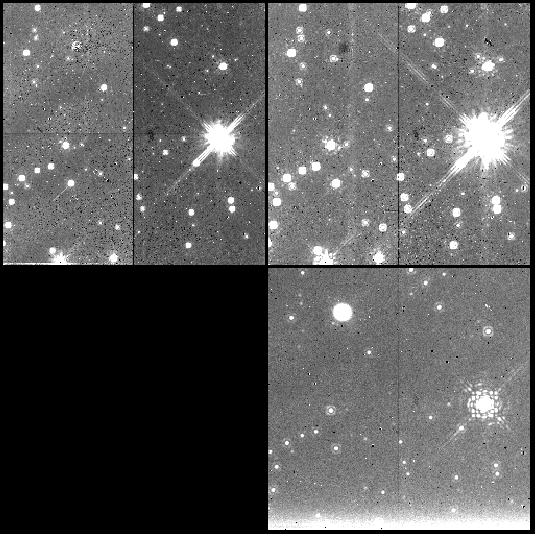 |
Our first step in the analysis of the parallel images has been to re-calibrate them, by matching the raw images with the best available on-orbit dark current and flat-field frames. Comparison of the resulting images with those processed through the STScI calibration pipeline indicates a maximum improvement of approximately 3% in photometric accuracy. This increased accuracy should also improve our color classifications of the objects in the F110W, F160W, and F222M filters.
We have derived colors in these filters for a wide range of objects, including normal stars, brown dwarfs, young galaxies, ultraluminous infrared galaxies, and QSOs. We have found that in most cases there is a good separation of the different classes of object in the plane of the (F110W - F160W), (F110W - F222M) color indices, which can be measured for the Camera 2 observations. These colors were derived using model and actual spectra of the objects (e.g., Kurucz model spectra of stars; Kurucz 1992). The colors were derived by convolving the filter transmission curves (factoring in detector quantum efficiency) with these object spectra, and taking the ratio of the integrated fluxes of the resulting spectra. An illustration of this method is shown in Figure 2, which compares the Camera 2 F110W, F160W, and F222M filter transmission curves with a composite spectrum of several hundred QSOs discovered in the Large Bright Quasar Survey (Francis et al. 1991). The composite spectrum has been redshifted to z = 6, and we have derived colors for this spectrum over the range 3  z
z  10. For active galaxies at low redshift, we have used the interpolated nuclear spectrum of the highly luminous Seyfert 2 galaxy Markarian 231 as a guide. Our efforts to derive object colors are
not yet complete, and in particular we are currently working on deriving the
colors of high-redshift supernovae using their optical and ultraviolet spectra.
10. For active galaxies at low redshift, we have used the interpolated nuclear spectrum of the highly luminous Seyfert 2 galaxy Markarian 231 as a guide. Our efforts to derive object colors are
not yet complete, and in particular we are currently working on deriving the
colors of high-redshift supernovae using their optical and ultraviolet spectra.
Figure 2:
Comparison of NICMOS Camera 2 F110W, F160W, and F222M filter transmission curves (dotted lines) with the Large Bright Quasar Survey
composite quasar spectrum, redshifted to z = 6. Flux units are arbitrary. Colors in this filter set were derived from the convolution of spectra such as this with the filter transmission curves.
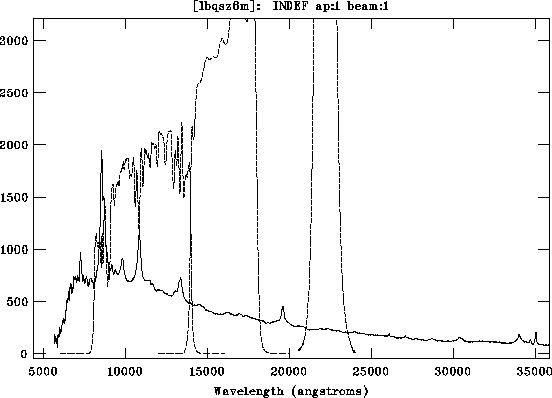 |
Of particular current interest is the detection of brown dwarfs and very low-mass stars, and the determination of their mass function and space density. Burrows et al. (1997) have generated model spectra of brown dwarfs in the infrared and determined the detection thresholds associated with current and planned infrared space missions. While Burrows et al. find that the spectra of brown dwarfs depend in a complex way on their age, mass and composition, the 0.1  Jy sensitivity limit of the NICMOS parallel observations should allow the detection of a certain range of them out to a distance of approximately 10 pc. The spatial resolution of NICMOS could also lead to the detection of brown dwarfs in close binary systems such as Gl 229B, which is difficult from the ground.
Jy sensitivity limit of the NICMOS parallel observations should allow the detection of a certain range of them out to a distance of approximately 10 pc. The spatial resolution of NICMOS could also lead to the detection of brown dwarfs in close binary systems such as Gl 229B, which is difficult from the ground.
Figure 3 shows the color-color diagram for Camera 2, for the spectra of point sources. The sensitivity limit of these observations should also allow the detection of the recently discovered population of young ( 1 Gyr) star-forming galaxies at z
1 Gyr) star-forming galaxies at z  3 (Steidel et al. 1996), based on their K-band fluxes, as well as star-forming galaxies at lower redshifts. In Figure 4 we show the Camera 2 color-color plot for a 1 Gyr-old galaxy over a wide range
of redshifts, using the population synthesis model of Bruzual & Charlot (1993). While the detection of such galaxies out to z
3 (Steidel et al. 1996), based on their K-band fluxes, as well as star-forming galaxies at lower redshifts. In Figure 4 we show the Camera 2 color-color plot for a 1 Gyr-old galaxy over a wide range
of redshifts, using the population synthesis model of Bruzual & Charlot (1993). While the detection of such galaxies out to z  10 in these
observations is not possible under normal circumstances, lensing of such sources
by a foreground galaxy cluster could raise their fluxes to the detection
level. The limitation of the Camera 1 and 3 wide-band observations to the F110W and F160W filters should still allow the identification of sources of interest such as infrared luminous galaxies and young galaxies at very high redshift, which as may be seen from Figures 3 and 4 have negative values of the (F110W - F160W) color index. Embedded young stellar objects also have spectra which peak in the far infrared (Green & Lada 1996), and as a result can also be identified by negative values of this index.
10 in these
observations is not possible under normal circumstances, lensing of such sources
by a foreground galaxy cluster could raise their fluxes to the detection
level. The limitation of the Camera 1 and 3 wide-band observations to the F110W and F160W filters should still allow the identification of sources of interest such as infrared luminous galaxies and young galaxies at very high redshift, which as may be seen from Figures 3 and 4 have negative values of the (F110W - F160W) color index. Embedded young stellar objects also have spectra which peak in the far infrared (Green & Lada 1996), and as a result can also be identified by negative values of this index.
Figure 3:
The expected color indices of point sources in the JHK-analog filters in Camera 2. The color indices are defined as the log of the ratio of fluxes in each filter. The points represent a combination of model and actual spectra, e.g. the values for the compact planetary nebula HB 12 were measured from low-resolution spectra obtained with the NICMOS grisms. For stars, Kurucz models were used due to their uninterrupted coverage through the near infrared.
However, this region is poorly modeled at low temperatures, so we have used
the near infrared spectrum of the M 6 star Gl 406 as a guide for such objects.
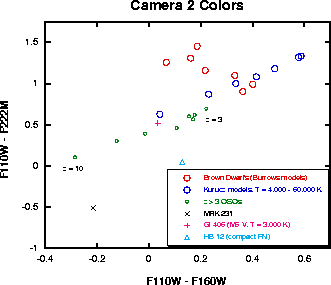 |
Figure 4:
The expected color indices in Camera 2 for a Bruzual & Charlot model galaxy spectrum. The model age is 1 Gyr and assumes a constant star formation rate.
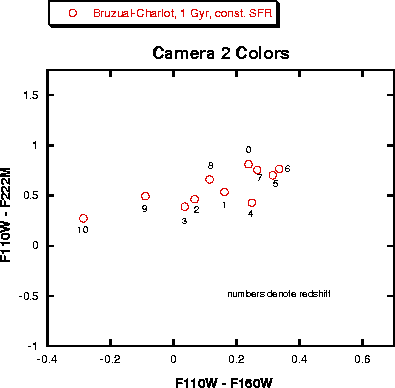 |
We have developed an IDL-based interface for the batch photometry program DoPhot
(Schechter, Mateo, & Saha 1993) designed specifically for the processing
of NICMOS images. Compared to other photometry packages, DoPhot offers the advantages of being able to fit an empirical PSF, and has easily
adjustable detection thresholds and aperture sizes. Our interface, called NICPHOT, operates on NICMOS images by first multiplying by the exposure time image to convert from adu/s, then allowing the interactive measurement of image background levels and PSFs. The DoPhot programs are then run, generating an output list of object positions, shape classifications, and instrumental magnitudes. We are developing a separate IDL program, NICCAT, to take these output files and determine object fluxes, colors (corrected for Galactic extinction), and the associated classifications. By applying NICPHOT and NICCAT together to the parallel images we expect to obtain fluxes and tentative classifications for all the objects they contain. The application of these programs is not limited to the parallel images, and we are making them available to the community. In particular, we encourage their application to background sources in deep pointed observations with NICMOS to allow the serendipitous discovery of interesting objects. NICPHOT does not treat grism images; this is best done by using the routine NICMOSlook (Freudling 1998).
The parallel observations are in no sense complete, and because of the small area of sky covered cannot be considered a survey from which reliable number counts can be made (see, however, McCarthy et al. 1998). However, the detection of any brown dwarf and very high redshift galaxy and QSO candidates is important. Specifically, in the case of the former, more examples are required to allow detailed study through follow-up spectroscopy, which is possible with 10m-class telescopes such as the VLT and Keck. In the case of QSOs, any detection of objects above z  5 would run contrary to evidence that their space density above such redshifts drops nearly to zero (Shaver et al. 1996). The high angular resolution and dust penetration of NICMOS observations in the Galactic plane also holds promise for refinement of stellar number counts and population modeling towards the Galactic center. Finally, as with any observations of this type, there is always the possibility of detecting new classes of objects, and our classification algorithm is structured accordingly.
5 would run contrary to evidence that their space density above such redshifts drops nearly to zero (Shaver et al. 1996). The high angular resolution and dust penetration of NICMOS observations in the Galactic plane also holds promise for refinement of stellar number counts and population modeling towards the Galactic center. Finally, as with any observations of this type, there is always the possibility of detecting new classes of objects, and our classification algorithm is structured accordingly.
Full processing of the parallel images with the aforementioned software and the generation of a source catalog is expected to take several months. However, we have to date inspected all of the parallel images taken through 1997 December. In addition to the aforementioned blank fields and blurred images, we have noticed few galaxies relative to point sources, and among these several interacting systems, which are likely to be infrared-luminous. Inspection of the images also reveals a wide range in source density, ranging from the blank fields to fields at low Galactic latitude which are sufficiently rich that the photometry algorithm will be challenged to distinguish individual sources.
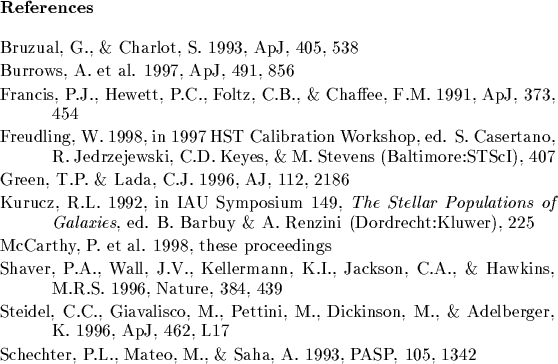




Next: The Old Stellar Population
Up: NICMOS Science
Previous: The Formation and Evolution
Norbert Pirzkal
1998-07-09

![]() z
z ![]() 10. For active galaxies at low redshift, we have used the interpolated nuclear spectrum of the highly luminous Seyfert 2 galaxy Markarian 231 as a guide. Our efforts to derive object colors are
not yet complete, and in particular we are currently working on deriving the
colors of high-redshift supernovae using their optical and ultraviolet spectra.
10. For active galaxies at low redshift, we have used the interpolated nuclear spectrum of the highly luminous Seyfert 2 galaxy Markarian 231 as a guide. Our efforts to derive object colors are
not yet complete, and in particular we are currently working on deriving the
colors of high-redshift supernovae using their optical and ultraviolet spectra.

![]() 1 Gyr) star-forming galaxies at z
1 Gyr) star-forming galaxies at z ![]() 3 (Steidel et al. 1996), based on their K-band fluxes, as well as star-forming galaxies at lower redshifts. In Figure 4 we show the Camera 2 color-color plot for a 1 Gyr-old galaxy over a wide range
of redshifts, using the population synthesis model of Bruzual & Charlot (1993). While the detection of such galaxies out to z
3 (Steidel et al. 1996), based on their K-band fluxes, as well as star-forming galaxies at lower redshifts. In Figure 4 we show the Camera 2 color-color plot for a 1 Gyr-old galaxy over a wide range
of redshifts, using the population synthesis model of Bruzual & Charlot (1993). While the detection of such galaxies out to z ![]() 10 in these
observations is not possible under normal circumstances, lensing of such sources
by a foreground galaxy cluster could raise their fluxes to the detection
level. The limitation of the Camera 1 and 3 wide-band observations to the F110W and F160W filters should still allow the identification of sources of interest such as infrared luminous galaxies and young galaxies at very high redshift, which as may be seen from Figures 3 and 4 have negative values of the (F110W - F160W) color index. Embedded young stellar objects also have spectra which peak in the far infrared (Green & Lada 1996), and as a result can also be identified by negative values of this index.
10 in these
observations is not possible under normal circumstances, lensing of such sources
by a foreground galaxy cluster could raise their fluxes to the detection
level. The limitation of the Camera 1 and 3 wide-band observations to the F110W and F160W filters should still allow the identification of sources of interest such as infrared luminous galaxies and young galaxies at very high redshift, which as may be seen from Figures 3 and 4 have negative values of the (F110W - F160W) color index. Embedded young stellar objects also have spectra which peak in the far infrared (Green & Lada 1996), and as a result can also be identified by negative values of this index.


